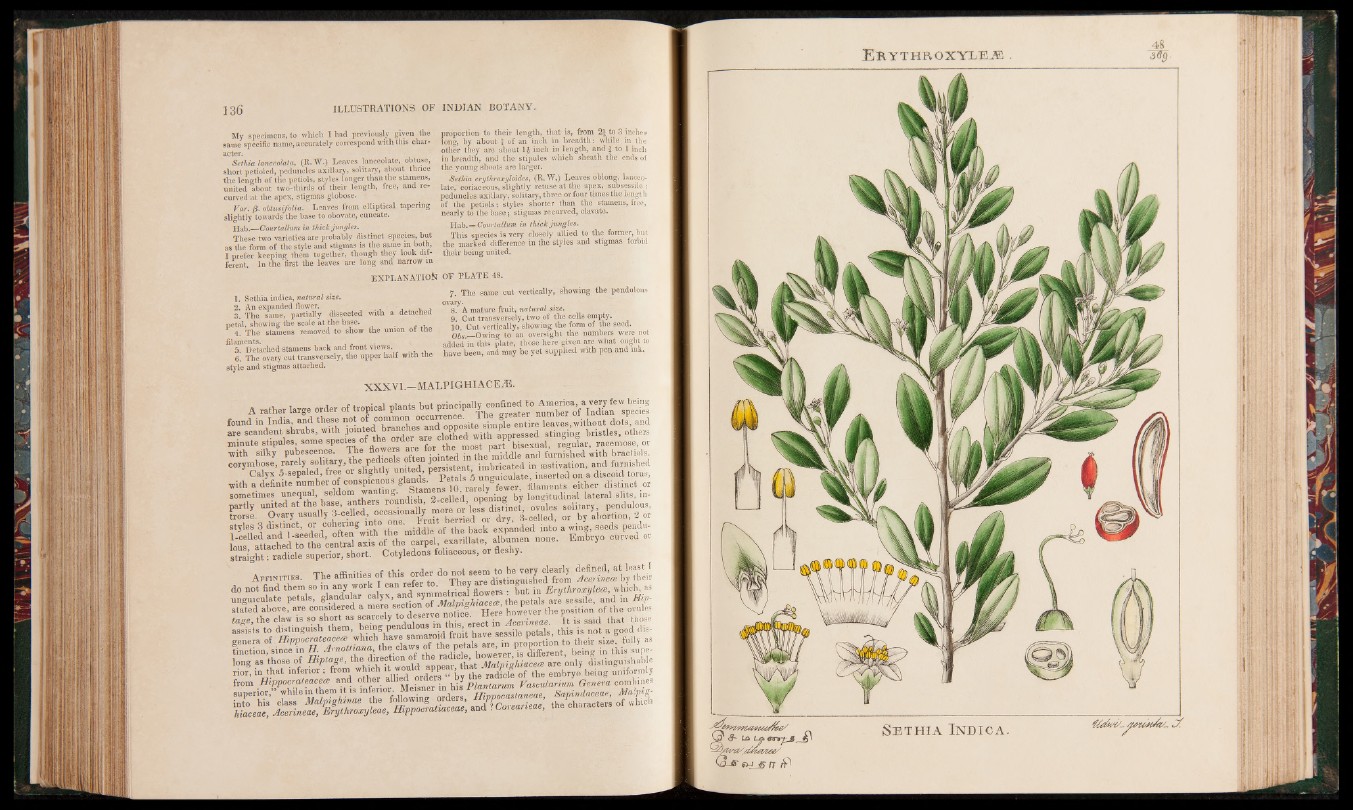
My specimens, to which I had previously given the
same specific name, accurately correspond with this character.
Sethia lanceolata, (R. W.) Leaves lanceolate, obtuse,
short petioled, peduncles axillary, solitary, about thnce
the length of the petiols, styles longer than the stamens,
united about two-thirds of their length, free, and recurved
at the apex, stigmas globose. '
Var. 0. obtusifolia. Leaves from elliptical tapering
slightly towards the base to obovate, cuneate.
Hab.— Courtallum in thick jungles.
These two varieties are probably distinct species, but
as the form of the style and stigmas is the same in both,
I prefer keeping them together, though they look different.
In the first the leaves are long and narrow in
proportion to their length, that' is, from 2§ to 3 inches
long, by about § of an inch in breadth: while in the
other they are about 1 \ inch in length, and | to I inch
in breadth, and the stipules which sheath the ends of
the young shoots are larger.
Sethia erythroxyloides, (R. W.) Leaves oblong, lanceolate,
coriaceous, slightly retuse at the apex, subsessile :
peduncles axillary, solitary, three or four times the length
of the petiols: styles shorter than the stamens, free,
nearly to the base; stigmas recurved, clavate.
Hab.—Courtallum in thick jungles.
This species is very closely allied to the former, but
the marked difference in the styles and stigmas forbid
their being united.
EXPLANATION OF PLATE. 48.
1. Sethia indica, natural size.
2. An expanded flower. • . . , ,
3. The same, partially dissected with a detached
petal, showing the scale at the base.
4. The stamens removed to show the union of the
filaments. „ ,
5. Detached stamens back and front views.
6. The ovary cut transversely, the upper half with the
style and stigmas attached.
7. The same cut vertically, showing the pendulous
ovary.
8. A mature fruit, natural size.
9. Cut transversely, two of the cells empty.
10. Cut vertically, showing the form of the seed.
0},S'__Owing to an oversight the numbers were not
added in this plate, those here given are what ought to
have been, and may be yet supplied with pen and ink.
X X X V I— MALPIGHI AC EM.
A rather large order of tropical plants but principally c o n f i ^
found in India, and these not of common occu^ence.^^ ^ g leaveSjVithoot dotS; and
are scandent shrubs, with jointed branc r>nthed with appre=sed stinging bristles, others
minute stipules, some species of the pT b isex u a l rfgular, racemose, or
with silky pubescence. The flowers a r e g g f tH g L . j | M ^ furnisghed with bracti
corymbose, rarely solitary, th e Pe,"V;e • . . L rsistent imbricated in estivation, and furnished
Calyx 5-sepaled, free or slightly u n i t e d « B E V ;nserted on , g H torus,
w ith a definite number of conspicuous g gtamens 1Q rare! Sfewel% filaments either distinct or
sometimes unequal, seldom wan S- d opJning by longitudinal lateral slits, mpartly
united at the base, anthers round, h t f l E W B O H ov5les 1 pendulous,
trorse. Ovary usually 3-celled, ■ w g & S K i M dI , 3-celled, or by abortion, 2 or
straight: radicle superior, short. Cotyledons foliaceous, or fleshy.
Affinities. The affinities o f E B B HShhIh H mM unguiculate petals, glandular ca > , o' Mnlnrahiacece the petals are sessile, and in m m
stated above, are considered a mere se,=tmnof M p z g j M the p ,h sition 0f the ovules
tage, the claw is so short as scarcely to deserve.no « e r e | | | | ^ 1 said M H
assists to distinguish them, b e i n g * ? d *_■. have sessile petals, this is not a good dis-
genera of Hippocrateaceai which ave . i are in proportion to their size, fully as
Suction;since in H. Arnottmua the claws of th e c a l ‘h ^ ’^ J s Sifferent, being in this .up.-
long as those of Hi’ptage, the direct > iWnlniohiacetB are only distinguishable
riorS,in that inferior; from which it would b d ng uniformly
EK Y TH R .O X Y L BÆ
tnrrrjB Jl Sethia Indica.